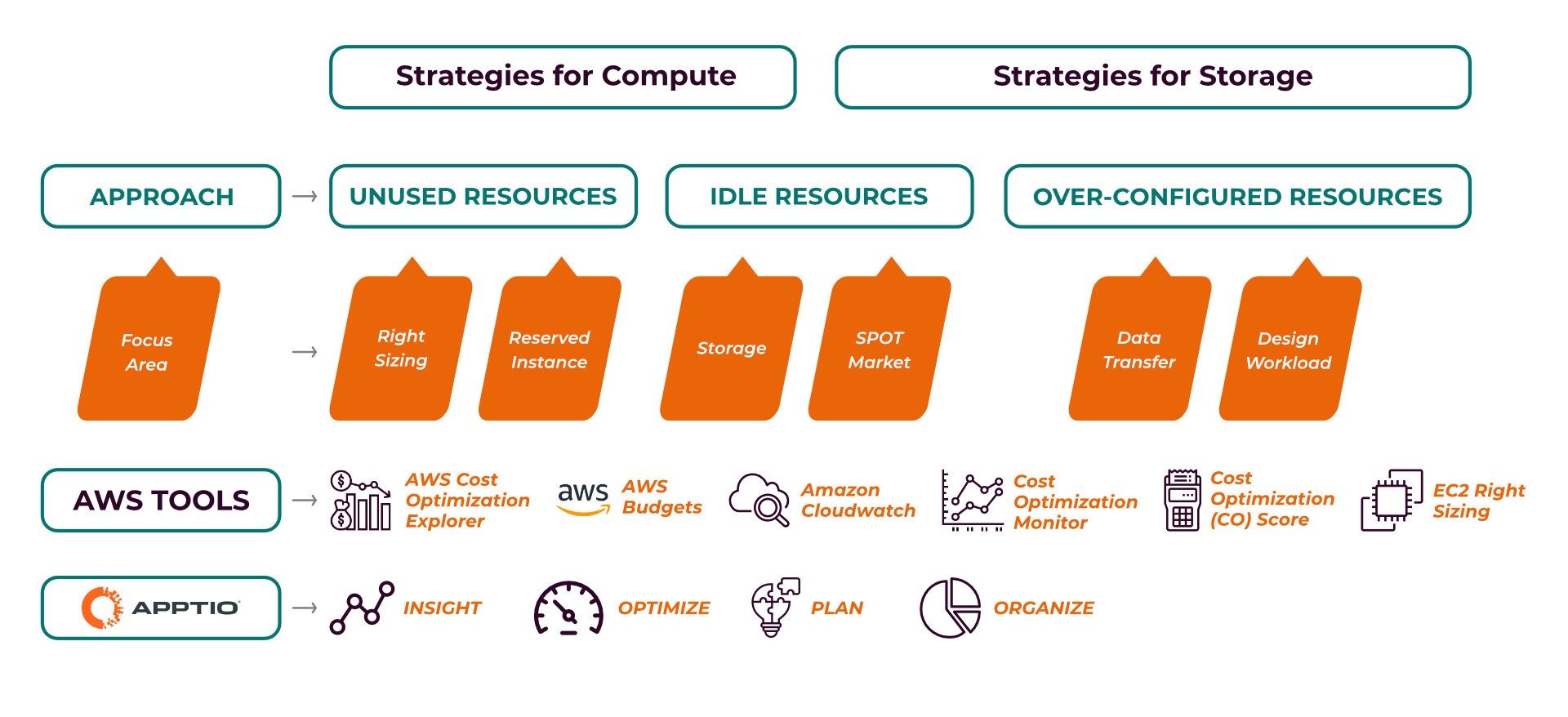The COVID-19 crisis gave a significant impetus to digital transformation globally. According to the McKinsey Global Survey of executives, nearly 80% of the customer interactions of respondents are digital. With digital transformation being one of the top business priorities, cloud adoption went on an upward spiral in the recent past. The adoption of Amazon Web Services (AWS) cloud over 2020 grew by approximately 30%, which in turn has revved up the emphasis on cost optimization.
However, the underlying impact of the crisis was visible in the way organizations, nearly 50%, panic-bought numerous services. This was primarily attributed to their strive in maintaining their edge amid the tightening market dynamics. Rightsizing their cloud spend has become imperative for organizations, to gain complete visibility of consumption and optimize costs even as maximizing ROI.
<spanarial’,sans-serif;color: #222222″=””> 6 Effective Ways to Reduce AWS Cloud Cost</spanarial’,sans-serif;color:>
Following are some of the effective ways for organizations to reduce their AWS cloud costs
Identifying Underutilized Amazon EC2 Instances
The AWS cost explorer resource optimization helps get the report on EC2 instances, which are under low utilization or are idle. Downsizing or shutting these instances can help organizations reduce their costs. Moreover, the AWS Compute Optimizer delivers recommendations that go beyond downsizing across instance families, removing performance bottlenecks. Using Amazon EC2 spot and on-demand instances further help in reducing costs.
If organizations increase the capacity when they scale up, they also reduce the capacity when they scale down. Rightsizing is a best practice in the case of instances whose peak utilization is not excessive. Analysis of the utilization metrics is imperative for seeking opportunities in moving workloads to different sets of instances that are in line with the requirements.
Optimized Continuous Delivery Process
Organizations that look to increase speed-to-market with numerous non-production environments often end up spending high on infrastructure costs. However, these costs can be reduced with the implementation of light and an optimized continuous delivery process. This helps organizations in driving cost-effective launches in production environments along with controlled, well-monitored releases.
Moving the testing stage to individual applications or microservices in isolation can further help organizations in implementing an optimized continuous delivery process. Most defects are found in testing at the service level. Accurate implementation of the test data is touted to ensure organizations see a high test coverage. Another key best practice for reducing the costs is mitigating the integration testing environment, which includes user acceptance, functional integration, staging, and performance integration.
Assessing Amazon RDS and Amazon Redshift Instances
AWS helps organizations in identifying DB instances that are out of connection over a week’s time, which can be stopped to optimize costs. Organizations can also identify Redshift clusters and pause the ones whose average CPU utilization is less than 5% using automation best practices. In the past, organizations could only avail discounts on heavy utilization with advanced payments. However, the pattern has now changed to mirrored Reserved Instance purchases for Amazon RDS.
Identifying Underutilized Amazon EBS Volumes
Various Amazon EBS volumes are under low activity and identifying these volumes enables cost reduction. Organizations can take the snapshots of these volumes and identify after which one to keep or eliminate. The Amazon Data Lifecycle Manager allows organizations to automate the snapshot creation process, in turn driving convenience and process efficiency.
A key challenge that organizations usually face is finding unused assets when they follow AWS cost optimization best practices. It is increasingly difficult to pinpoint unattached IP addresses in AWS Console. However, partnering with the right cloud service provider and implementing the right tools can help organizations with complete visibility of cloud environments.
Networking Review
With the report of load balancers, organizations can prevent unnecessary ELB consumption. In case a significant cost is involved in transferring the data from EC2, organizations can use Amazon CloudFront, as it eliminates the need for over-provisioning capacity for catering to potential traffic rise.
Analyzing Amazon S3 Usage
Analyzing storage access patterns on data sets using S3 Analytics delivers organizations with recommendations on the areas where Amazon S3 can be leveraged for cost reduction. They can even automate transitioning the resources into a relatively low-cost tier. Currently, AWS provides 6 storage tiers with different price points. Organizations must be capable of deciding which storage tier to be selected for their data. Some factors influencing the selection include the frequency of the data being accessed and the minimum recovery time needed to retrieve the data during a disaster.
How Blazeclan & Apptio Together Facilitate Cloud Cost Optimization
With the growth in cloud usage coupled with the size of billing data, you need to process and analyze in a timely manner to be effective this optimization challenge has gone beyond manual efforts.
Organizations require a simplified cost management process that offers end-to-end visibility of their cloud environments while gaining trusted data-driven decisions to help minimize the risk of investments. Organizations that do not have a proven cloud financial management plan for their AWS cloud environment are likely to overspend approximately 70%. Blazeclan’s cSaver framework, combined with Apptio’s leading cloud financial management solution, Cloudability, assists organizations with an effective, machine learning-driven cost optimization model.
Key benefits of the combined solution include
- Ownership of cloud costs and optimizing the cloud economics.
- Rightsizing cloud usage to realize cost and operational efficiencies.
- High-end tool-driven analysis and clear inventory visibility.
- Consulting for cloud spend optimization.
- Driving strategic cost transformation.
The Framework
The Need of The Hour
Cloud cost optimization has become a high priority in development and delivery processes. With the cSaver framework, organizations can minimize their spending with responsive and resilient deployments. Leveraging tools, techniques, and best practices of cloud cost optimization is the need of the hour for making the operations more agile and the system more reliable.



















